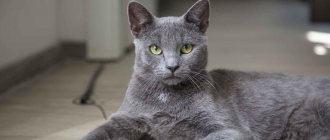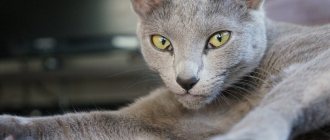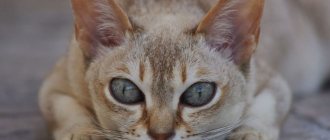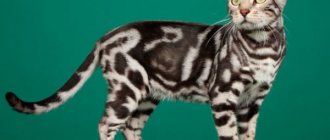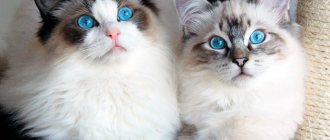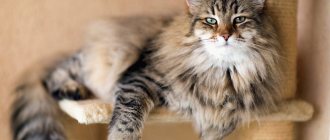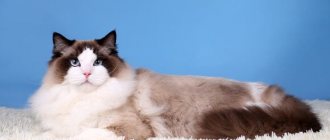Representatives of this breed, like other furry pets, regardless of gender and age, can be charming, playful and playful.
Here useful information will be provided on how to organize food, how to take care of the fur, how to care for it in case of illness, and other things that those who have chosen a Siberian blue cat as a pet need to know.
This information will be useful and interesting to those who adore cats and want to purchase or adopt a representative of this breed into their home. However, you need to know that the cost of these beauties is usually quite high, due to the unique features of the breed, however, there are exceptions.
Breed standard Russian Blue
These cats are among the most fashionable, and not only in the post-Soviet space. They have short fur, an elongated body, an elegant neck, and an elongated and tapering tail. The limbs are long, the paws are smoothly outlined (see photo of the Russian Blue cat).
A distinctive feature of these animals is the silver color of their fur with a bluish tint. The main hairs and the undercoat are characterized by the same length, which is why the coat looks dense and silky.
The following are considered defects:
- gap in bite exceeding 0.2 cm;
- downward deflection of the spine;
- deep-set eyes;
- the presence of stains on the fur leads to disqualification;
- Aggressive behavior also leads to rejection.
How to care for the breed
Siberians need regular:
- Combing – it is enough to carry out manipulations 2 times a week using a special brush made of natural bristles. Systematic brushing will prevent hair from entering the esophagus. Shedding in cats occurs in the autumn-spring period. During these days, it is recommended to brush daily.
- Trimming the transparent part of the claws with a special nail clipper. If you don’t want to cut your hair, you can buy a scratching post at the store and the problem of damaged furniture will be irrelevant.
- Bathing – several times a year using a special shampoo.
- Cleaning the ears with a cotton pad soaked in hydrogen peroxide.
- To cleanse the eyes , use a cotton pad soaked in water.
Feeding
Despite the abundance of cat food, it is advisable to provide your pet with a balanced diet based on natural products. It is very important to serve only fresh food. When creating a menu for your pet, you should include:
- low-fat fish;
- chicken fillet;
- turkey;
- beef;
- kidneys;
- hearts;
- ventricles;
- lungs;
- low-fat kefir and curd mass;
- low-fat sour cream;
- potato;
- vegetable oil;
- corn oil;
- oatmeal;
- semolina porridge;
- rice and buckwheat porridge.
Dairy food is usually served in the morning, and meat delicacies with porridge in the afternoon. To maintain immunity, you should regularly include vitamin and mineral supplements in your meals.
If, however, feeding your baby is based on food, then premium products . They include a sufficient amount of microelements and vitamin complexes.
No matter how strong love and affection for a pet is, it should not be shown through food. Considering the animal’s tendency to become overweight and its great desire to constantly chew something, you should carefully monitor the size of the portions eaten so as not to harm the Siberian.
Health
Thanks to the quality work of breeders, Siberian blue cats can boast of good health. However, if basic care rules are not followed, the animal may develop problems with the digestive system and respiratory organs. The life expectancy of cats is 18-20 years, which cannot but please their owners.
Features of the Siberian Blue breed
These cats are considered semi-longhaired. The bluish coloration of the fur of Siberian cats was obtained as a result of crossing animals with a silver color and a recessive coloration with no agouti.
According to the standard, the fur of this breed is supposed to be uniformly colored along the entire body and have no hints of pattern.
Character, habits
Cats of this breed are not aggressive, but have a wayward character.
As kittens, they can be playful and have no problem making contact, but once they reach adulthood, the individual begins to highly value their personal space and does not really like it when it is invaded.
You can pet your pet only with his permission.
The habits of a predator also appear. The cat's attention can be attracted by small domestic animals - birds or rodents. However, powerful claws and fangs are rarely used. As a rule, Siberian Blues are peaceful and calm.
The emergence of the Russian Blue
These cats first appeared on the territory of Russia, but British citizen Karen Cox began deliberately selecting the breed. In 1893, she brought two kittens from Arkhangelsk to England.
During the Second World War, these cats were threatened with complete oblivion, but with the further work of specialists they were saved. In their historical homeland, interest in these internationally revered animals arose only in the last decade of the 20th century.
Domestic felinologists brought imported cats together with home-grown ones, and as a result, the Russian Blue breed re-established itself in Russia.
History of the origin of breeds
K. Cox made a huge contribution to the history of the origin of the Russian blue cat, who, after purchasing several blue kittens in Russia (Arkhangelsk region), went to the UK and began breeding them. However, there were few cats, the breeder began to experiment and try to cross them with other breeds of the same color. More often than not, this did not bring the desired result, and the cats did not have plush fur.
Russian Blue cat is a leader in life
For your information! During World War II, the Russian blue cat was almost on the verge of extinction. English breeders made every effort to preserve this species.
The history of the appearance of Siberian cats is completely unknown. There are several assumptions about this. One of them says that the breed arose after crossing domestic cats with taiga cats. Another thing is that this merit belongs entirely to the breeders, who were tasked with breeding a new species of cats similar to wild feline animals.
In the 16th century The first mentions of this breed were found. At that time they were called Bukhara.
Siberian cat in all its glory
Siberian blue
Thus, through the efforts of our and English felinologists, not only Siberian beauties with long hair were obtained, but also with short hair (see photos of Siberian cats of the standard breed).
Siberian fur does not cause allergies, so people suffering from this scourge can afford them.
Possible deviations
Siberian blue cats are not allowed to participate in exhibitions with:
- an elongated and puny body, a thin skeleton, long limbs and neck;
- narrow, high cheekbones, flattened muzzle with a sharp chin;
- small, round eyes deeply sunk into the skull;
- large or small ears located close to each other;
- short or long tail, not fluffy enough;
- weak or absent undercoat;
- not shiny, tending to get tangled with guard hairs;
- hairless indentations between the toes.
Temperament of the Siberian Blue
This breed has a freedom-loving character and a very pronounced sense of self-importance. She does not pester people in search of affection and allows herself to be petted only in a good mood.
From her distant ancestors she retained a strongly manifested hunting instinct. They are capable of catching not only small rodents; rabbits and ferrets sometimes become their prey. However, these furry predators are quite good-natured and friendly with humans.
The history of the appearance of the Siberian cat
One of the oldest breeds known to man, formed naturally. Many legends and myths have developed about the appearance of this cat next to a person. Its characteristic appearance and powerful large body gave rise to a legend about its relationship with the Siberian lynx.
But the Siberians themselves in ancient times called this cat Bukhara, which came from Bukhara, foreign. The first mention of this domestic animal in handwritten sources dates back to the sixteenth century. It is not possible to establish the exact time of appearance of the species. The population of Siberia mainly led a nomadic lifestyle; there were only a few large settlements - camps (khan headquarters), where livestock, dogs and cats were kept.
There are several versions of how a long-haired cat was able to get into the taiga and survive there. Three of them are noteworthy:
- They appeared in Rus' in the eleventh and twelfth centuries as Byzantine gifts to the ruling princes. Females with Persian roots actively crossed with forest semi-wild cats.
- Domestic cats of immigrants to Siberia from the West naturally crossed with wild forest cats, the genotype changed, adapting to harsh climatic conditions.
- The ancestors of the Siberian were brought by Eastern merchants during the period of active trade (Silk Road) and have Asian roots. It is very likely that Siberian, Persian and Angora cats have common roots. The animals adapted to local conditions through a process of natural mutation. Snow, frost, and a long winter in the Urals and Siberia contributed to the appearance of long hair with water-repellent properties and a thick, warm undercoat that warms the animal in bad weather. And Vologda merchants brought Bukhara kittens to middle and central Rus'.
The unconditional hunting gift of these mighty beauties has always been highly valued by man and is their undeniable advantage. During the Great Patriotic War, it was these cats that saved the country from a rodent invasion. After the liberation of Leningrad from the siege, the furry Siberians were donated to the residents of the city for the next battle for human life - this time with rats.
Moscow and St. Petersburg Siberians became representatives of this breed from Russia at world felinological exhibitions.
The path to the official formation of the breed:
- The first of the first was the cat Roman (born in 1987). In the same year, the first nursery “Nevsky” opened in Germany.
- In 1989, felinologists of the Soviet Union proposed the name of the breed “Moscow”, it was rejected and officially assigned “Siberian”.
- In 1992, Siberian Dimka Laskovy Zver became the first World Champion in the WCF system. One of the Siberian subspecies, the Nevsky Masquerade, is registered as a separate breed.
- 1995 - the first special breed exhibition “Siberian Miracle” began its work in Moscow.
- In 1996, the breed was officially registered in the international felinological system TICA.
- 1997 - recognition in the FIFe association and the opening of the first club for breed lovers;
- 2006 - recognition by the American CFA system. Siberian Fenya Lynx wins world and European champion titles.
Thanks to his unique appearance and character, which deserves respect, the Siberian hunter has more than once become the hero of folk tales and even entered classical literature - it was he who became the prototype of the “scientist cat” from A. S. Pushkin’s poem “Ruslan and Lyudmila”.
This handsome man is rightly called the national treasure of Russia.
Conditions and care for Russian Blue
Cats of this breed do not need any specific living conditions. They adapt perfectly to both apartment living and country house living.
You should brush your pet's fur once a week. This is necessary so that the fallen hairs do not scatter throughout the home.
Disinfection of the eyes, ears and mouth is carried out only when it is really necessary. It is necessary to have a good scratching post at home so that the furniture does not suffer.
Food for Siberian blue
Adult cats are given food twice a day. The approximate weight of food eaten by an animal fluctuates around 200 grams, the exact calculation is carried out based on the 50 grams of food per 1 kg of body weight.
Good metabolism is promoted by the constant availability of fresh drinking water.
Russian blue eye color
Representatives of this breed should always have green eyes. If their color is yellow, then the cat is considered defective.
Allergies and Siberian Blue
These animals are unique in that their long hair almost does not cause allergies. Siberians with blue coats have more delicate and fluffy fur than other cats.
Thanks to this, the hairs are less likely to be damaged and broken; this circumstance further improves the hypoallergenic properties of this breed.
Features and behavior
Siberian blue cats are very beautiful, affectionate animals with a melodious voice. They are very loyal to their owner and truly enjoy spending time with him.
However, in addition to attachment to a loved one, the cat remains independent and will never bother you when the owner is in a hurry. It’s quite easy to ruin your relationship with your pet if you show aggression and anger. The presence of excellent intelligence and intelligence allows cats to understand human speech and capture the mood.
The main feature of the breed is the lack of instinct to scratch a person. When communicating with the owner and even playing with him, she will never release her claws.
Character
The character of the pet is quite soft. As a rule, cats are obedient, but if necessary, they can demonstrate their displeasure with slight disorder or damaged curtains. The pets do not accept being cuddled, but happily lie in the arms of the owner.
The Siberian treats strangers with restraint and wariness until he feels that the person is kind and will not cause harm. Cats get along well with children and other pets.
Rarely can conflicts arise between representatives of the breed and large dogs.
A pet can live not only in an apartment, but also in the private sector. Considering his love for catching mice, you don’t have to worry that your pet will be bored outside. He will happily hunt for rodents while his beloved owner is away at work. In addition, Siberians will happily go on a family trip to nature, where they will not run away and hide in the bushes, but will enjoy the fresh air next to people.
Pregnancy and birth in a Russian Blue
According to breeding standards, these cats can only be crossed with individuals of their own breed, since mating with other breeds leads to the birth of kittens characterized by defective appearance.
The pregnancy period is 65 days and usually proceeds without side effects.
These animals have excellent health by nature and are able to relieve themselves of the burden; they do not require the help or supervision of the owner in this process.
Description of appearance and standards
Siberian cats are quite large animals. Females of this breed weigh up to six kilograms, and males - up to twelve. But they are very mobile and have good jumping ability due to the fact that their hind legs are slightly longer than their front legs.
Siberian cats are quite large and powerful animals.
The Siberian fur coat is beautiful and practical. A distinctive feature is the frill and panties. Their coat is of medium length and has a dense undercoat, which helps the animal feel quite comfortable even in severe frosts. The body is muscular and strong, making the Siberian cat an excellent hunter.
Siberians belong to the “forest type” along with the Norwegian forest cat and Maine Coon. And if at first glance these animals are similar, then upon closer examination each will have its own characteristics. For example, the head of a Maine Coon has angular lines, it seems to be made up of several boxes, in a Norwegian the transition from the forehead to the muzzle is practically not pronounced, a kind of straight line, and in a Siberian the profile is smoother compared to the Maine Coon, but the transition from the forehead towards the muzzle is more clearly expressed than in the Norwegian Forest.
Forest type cats have significant differences in head structure
A common feature of “forest type” cats can be the so-called wild color (various agouti, including white, as well as brindle, spotted and marbled). But recently, breeders have become interested in breeding Siberian cats of all kinds of colors (since they are more in demand among exotic lovers), so after looking at the offers of different breeders, I got the impression that soon the ordinary “mustachioed-striped” will be considered exotic.
Breeding and lifespan of the Siberian Blue
For successful breeding of these cats, individuals with good immunity, similar colors and clearly manifested traits characteristic of this breed are selected.
Females reach full development for conceiving and bearing offspring by one and a half years. And after eight years they are considered unsuitable for producing breed standards. On average, these cats live up to 14-15 years.
See also beautiful photos of the Neva Masquerade cat.
Breeding and mating
To select a male for a female, you should contact specialists working at exhibitions. They will show the exhibition catalog and point out the advantages and disadvantages of the presented individuals.
2 weeks before mating, your pet should be treated for worms. The day before mating, trim the claws. The female is taken to the male, and they take with them a bowl, tray, and bed so that the cat does not feel uncomfortable visiting.
Animals are left in a cozy and warm room. You can pick up your cat in 1.5–2 days. After a month, signs of pregnancy will become noticeable. The Siberian cat usually gives birth to 5–8 cubs.
Lifespan
How long do Siberian cats live in a house or apartment, in our Siberian region and its climatic conditions? The breed makes us happy with these indicators. They live longer than other breeds. Even though this figure hasn’t gone up much, it’s still nice.
Recently, experts, according to statistics, have found that the life expectancy of the cat world and its inhabitants has increased significantly thanks to modern veterinary medicine, modern medications and healthy food.
On average, a Siberian cat lives up to 15 years. It is unknown how many years your pet has. Everything is determined by external factors and care. Timely sterilization and castration will bring many happy years of life.
It is difficult to say to what age Siberians grow. There are different colors and breeds of Siberian cats. Some grow up to a year, others are fully formed over several years.
Nutrition plays an important role in life expectancy. Specialized food, according to experts, prolongs life, unlike cats that eat anywhere and anything. The longer the kitten eats mother's milk, the better for it. It contains all the strength and nutritional elements.
Heredity and genes influence how many years a kitty will live. Diseases, health, and many other factors affecting life are transmitted from ancestors along the line. But there are also individuals who live 20 years or longer, but this is rare.
How long do Siberian cats live in the harsh conditions of apartment living? They may get injured or poisoned. Contact your veterinarian promptly for help if something happens to your pet. Do not delay under any circumstances.
Shorthair cat
photo: Smoky Shorthair
The Siberian Shorthair cat also belongs to the type of long-haired individuals. This breed originated in the Siberian Islands, with the participation of breeds from Britain and the European continent. Unlike the previous breed, its size does not exceed average. By color they can be tortoiseshell, chinchilla, plain or smoky.
It is distinguished by its slightly shortened paw length. The tail is not very long, the head is rounded, large in size, a massive strong neck, medium ears, the forehead is stretched slightly forward, and the nose, on the contrary, is recessed. The coat is short and of equal length.
Calm, difficult to succumb to aggression. Education does not allow you to react aggressively or attack an animal in the fight for an object, territory or food. Being self-confident, they will conquer whatever they like without difficulty or fight.
The Siberian smooth-haired cat is loyal only to its owner, easy to find a common language, and clean. Willful - will not allow you to dictate your terms. Requires proper care. Just like long-haired cats, this cat needs to be brushed to remove excess fluff. Even if the nutrition is correct, it will still be there, just not enough.
Health and illness
The lifespan of Siberian blue cats is 18–20 years. Representatives of the breed are in excellent health.
In rare cases, older cats develop:
- pathologies of the digestive tract;
- renal failure;
- diseases of the heart and blood vessels.
These diseases should be treated by a veterinarian.
Attention! Golden Siberian cats are susceptible to hypertrophic cardiomyopathy.
The most dangerous pathologies of Siberian cats are kidney stones and the formation of a hairball in the intestines. Advanced urolithiasis causes kidney failure. The hairball usually comes out in vomit. To make this happen faster, an adult cat should be given a large spoon of sunflower oil, and a kitten should be given a teaspoon.
Don't forget about annual vaccinations. When carried out in a timely manner, it protects the animal from fatal infectious pathologies: calcivirosis, rabies, rhinotracheitis, panleukopenia, chlamydia.

